|
|
|
Sort Order |
|
|
|
Items / Page
|
|
|
|
|
|
|
| Srl | Item |
| 1 |
ID:
176227
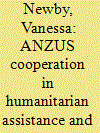

|
|
|
|
|
| Summary/Abstract |
This article discusses how the ANZUS states of United States, Australia, and New Zealand that sit on the fringes of the Asia-Pacific, are increasingly using their armed forces to deliver Humanitarian Aid and Disaster Response (HADR) as a way of engaging with the region. This is a neglected topic both in international relations and research on regional security in the Asia Pacific. This assessment reveals new developments in regional engagement between the ANZUS states and the Asia-Pacific. It finds that despite a shared language, broadly similar regional goals, and a need for interoperability; the ANZUS alliance itself does not appear to be driving closer military coordination on HADR. This article finds instead that HADR is being used to build new informal security networks that combine traditional and non-traditional security threats as a form of soft balancing against China.
|
|
|
|
|
|
|
|
|
|
|
|
|
|
|
|
| 2 |
ID:
176225
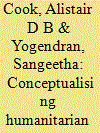

|
|
|
|
|
| Summary/Abstract |
The Asia-Pacific is a dynamic region that is exposed to multiple natural hazards. This article explores how recent developments have influenced the relationship between civilian and military actors in the Asia-Pacific to facilitate an improvement in humanitarian civil–military coordination to assist and protect disaster-affected communities. It investigates civilian and military engagement in disaster preparedness and response activities in the Asia-Pacific, and draws on the literature on civil–military relations and technical reports to further conceptualise these. This article analyses the 4Cs of disaster partnering in humanitarian civil–military partnerships in the Asia-Pacific—(1) Coexistence/Communication, (2) Cooperation, (3) Coordination, (4) Collaboration [Martin, E., I. Nolte, and E. Vitolo. 2016. “The Four Cs of Disaster Partnering: Communication, Cooperation, Coordination and Collaboration.” Disasters 40 (4): 621–643]. It argues that the Regional HADR Coordination Centre (RHCC), UN Cluster System, the Regional Consultative Group on Humanitarian Civil–Military Coordination for Asia and the Pacific (RCG), and Association of South East Asian Nations (ASEAN) centric mechanisms are illustrative of different orders of disaster partnering that are best understood as a combination of distinct and sequential activities. Through a clearer conceptualisation of humanitarian civil–military partnerships in the Asia-Pacific, this article aims to provide more informed expectations on what these partnerships may or may not deliver.
|
|
|
|
|
|
|
|
|
|
|
|
|
|
|
|
| 3 |
ID:
176223
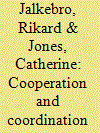

|
|
|
|
|
| Summary/Abstract |
East Asia (here consisting of China, Japan, North and South Korea, and the ten states of the ASEAN) is increasingly being considered as a region which is a potential crucible for conflict. Even the most optimistic authors recognise that there is the potential for security tensions to develop into more comprehensive kinetic actions. In the context of the growing trade tensions between China and the United States, which is drawing in other regional actors, the potential for economic interdependence to mitigate these tensions is reducing. Despite the context in this region we do, however, see evidence of cooperation and coordination emerging within the arena of (so-called) non-traditional security challenges. These papers explore different aspects of the cooperation that we see, and collectively they present the conditions under which there are positive cooperation outcomes in the areas of humanitarian assistance (HA) and disaster relief (DR) and/or peacekeeping operations (PKO). Collectively, they identify that mid-range theories have great explanatory power in exploring and researching this region.
|
|
|
|
|
|
|
|
|
|
|
|
|
|
|
|
| 4 |
ID:
176226
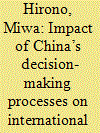

|
|
|
|
|
| Summary/Abstract |
International cooperation on peacekeeping operations, and on humanitarian assistance and disaster relief (HADR) operations, is important in tackling global non-traditional security threats. It also helps China address its ‘trust deficit’ problem. While both operations seem ‘low hanging fruit’ for international cooperation, the ways in which China undertakes peacekeeping and HADR cooperation differ – the former encompasses not only cooperation for technical and capacity development but also cooperation for policy harmonisation, while China’s HADR cooperation is limited to technical and capacity development. This paper asks, ‘why the difference?’, despite the fact that they both address similar policy problems. It argues that the difference corresponds to the level of holisticity/fragmentation of China’s decision-making process. The more holistic China’s decision-making process, the deeper the international cooperation. The nature of China’s decision-making processes has international policy implications, because the fragmented nature of those processes maintains cooperation at a functional level only, and hinders the deeper development of cooperation into policy harmonisation.
|
|
|
|
|
|
|
|
|
|
|
|
|
|
|
|
| 5 |
ID:
176224
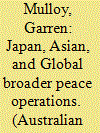

|
|
|
|
|
| Summary/Abstract |
This paper examines Japanese unity of Overseas Despatch Operation (ODO) actors, laws, and operational aspects, interaction with state and institutional actors, ‘4C’ functional regional engagement and concepts of partnership, and Japan’s United Nations Peace Operations-Humanitarian Assistance Disaster Relief Operations (UNPO-HADRO) nexus. Japanese cooperation for dual liberal-international peace and realist security goals within increasing regional strategic competition and nationalist antipathy is examined, particularly in Japan’s ‘poor neighbourhood’. The paper questions why, despite undoubted expertise, Japan has not emerged as a regional UNPO-HADRO development leader, and whether Japanese UNPO-HADRO and ‘pro-active pacifism’ approaches are utilising UNPO-HADRO for Asia-regional strategic competition purposes? Japanese ODO have played important functional engagement, value sharing, and institutional socialisation roles, with integrated legal-civil–military holistic approaches providing models for others and foundations for partnerships. However, despite specialist capacity-building knowledge transfer efforts Asian disquiet remains concerning cooperation and partnership. Japan remains highly risk-averse, raising questions regarding its dependability, and ‘HADRO-CIMIC superpower-aspirations’, or bridging-actor role between Indo-Pacific and ‘Northern-Developed’ practitioners, can be evaluated by Japan’s modest present UNPO actor status. Japanese leadership and initiative is limited by its neighborhood and attendant institutions, but also by its self-perceived identity shaped by historical, alliance, and leadership challenges to manage relative decline.
|
|
|
|
|
|
|
|
|
|
|
|
|
|
|
|
| 6 |
ID:
176228
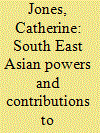

|
|
|
|
|
| Summary/Abstract |
Regions are becoming increasingly central to both the implementation and claims to legitimacy of UN peacekeeping operations. In 2008, in the UN Secretary General published a report on the relationship between the UN and Regional Organisations (S/2008/186**), highlighting that UN-regional partnerships should develop to entail wider capacity building activities, define and refine the responsibilities of regions and the UN in both Chapter VIII and non-chapter VIII activities, and perform functions in support of disarmament and mediation. However, ten years after the UN Secretary General’s report and four years after the HIPPO report there is still an urgent need to understand how, and in response to what drivers, are UN peacekeeping operations changing? In this paper I argue that because of the UN’s approach to partnerships it excludes learning from the contributions of other global potential partners including ASEAN. As a result, although there are pathways that make it possible for such a transfer of knowledge and experience, but these are often blocked—or perhaps just obscured—by the practices within the UN; for example, the institutional stickiness around partnerships.
|
|
|
|
|
|
|
|
|
|
|
|
|
|
|
|
|
|
|
|
|